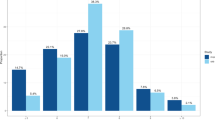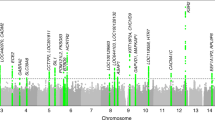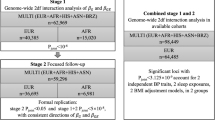Abstract
Sleep is vital for human health and has a moderate heritability. Previous genome-wide association studies have limitations in capturing the role of rare genetic variants in sleep-related traits. Here we conducted a large-scale exome-wide association study of eight sleep-related traits (sleep duration, insomnia symptoms, chronotype, daytime sleepiness, daytime napping, ease of getting up in the morning, snoring and sleep apnoea) among 450,000 participants from UK Biobank. We identified 22 new genes associated with chronotype (ADGRL4, COL6A3, CLK4 and KRTAP3-3), daytime sleepiness (ST3GAL1 and ANKRD12), daytime napping (PLEKHM1, ANKRD12 and ZBTB21), snoring (WDR59) and sleep apnoea (13 genes). Notably, 20 of these genes were confirmed to be significantly associated with sleep disorders in the FinnGen cohort. Enrichment analysis revealed that these discovered genes were enriched in circadian rhythm and central nervous system neurons. Phenotypic association analysis showed that ANKRD12 was associated with cognition and inflammatory traits. Our results demonstrate the value of large-scale whole-exome analysis in understanding the genetic architecture of sleep-related traits and potential biological mechanisms.
This is a preview of subscription content, access via your institution
Access options
Access Nature and 54 other Nature Portfolio journals
Get Nature+, our best-value online-access subscription
$29.99 / 30 days
cancel any time
Subscribe to this journal
Receive 12 digital issues and online access to articles
$119.00 per year
only $9.92 per issue
Buy this article
- Purchase on Springer Link
- Instant access to full article PDF
Prices may be subject to local taxes which are calculated during checkout






Similar content being viewed by others
Data availability
The main data, including the individual-level phenotypic and genetic data used in this study, were accessed from UK Biobank under application number 19542 and are available through UK Biobank (https://www.ukbiobank.ac.uk/). Summary GWAS statistics of FinnGen were obtained through https://r9.finngen.fi/. The single-cell sequencing data from the human brain were obtained from the Gene Expression Omnibus database (GSE173731). The single-cell sequencing data from the mouse central nervous system were obtained from the Mouse Brain Atlas (http://mousebrain.org/adolescent/).
Code availability
The code used for single-variant and gene-based analysis is an adaptation of the R package SAIGE-GENE+ v.1.1.6.2 (https://github.com/saigegit/SAIGE/). Quality control of individual-level data was performed using Hail v.0.2 (https://hail.is) and PLINK v.2.0 (https://www.cog-genomics.org/plink/2.0/). Variant annotation was performed using SnpEff v.5.1 (https://pcingola.github.io/SnpEff/). Burden heritability estimation was performed using BHR v.0.1.0 (https://github.com/ajaynadig/bhr/). The analysis and visualization of scRNA-seq data were performed using Seurat v.4.3.0 (https://github.com/satijalab/seurat/). GO enrichment analysis was performed using clusterProfiler v.4.2.2 (https://github.com/YuLab-SMU/clusterProfiler/). Tissue expression enrichment analysis was performed using FUMA v.1.5.6 (https://fuma.ctglab.nl/). Custom scripts for the analyses in this paper are available at https://github.com/cjfei18/sleep_wes.
References
Stranges, S., Tigbe, W., Gomez-Olive, F. X., Thorogood, M. & Kandala, N. B. Sleep problems: an emerging global epidemic? Findings from the INDEPTH WHO–SAGE study among more than 40,000 older adults from 8 countries across Africa and Asia. Sleep 35, 1173–1181 (2012).
Leng, Y., Musiek, E. S., Hu, K., Cappuccio, F. P. & Yaffe, K. Association between circadian rhythms and neurodegenerative diseases. Lancet Neurol. 18, 307–318 (2019).
Irwin, M. R. Sleep and inflammation: partners in sickness and in health. Nat. Rev. Immunol. 19, 702–715 (2019).
Fan, M. et al. Sleep patterns, genetic susceptibility, and incident cardiovascular disease: a prospective study of 385 292 UK Biobank participants. Eur. Heart J. 41, 1182–1189 (2020).
Cappuccio, F. P., D’Elia, L., Strazzullo, P. & Miller, M. A. Sleep duration and all-cause mortality: a systematic review and meta-analysis of prospective studies. Sleep 33, 585–592 (2010).
Lane, J. M. et al. Genetics of circadian rhythms and sleep in human health and disease. Nat. Rev. Genet. 24, 4–20 (2023).
Ambrosius, U. et al. Heritability of sleep electroencephalogram. Biol. Psychiatry 64, 344–348 (2008).
Gottlieb, D. J. et al. Novel loci associated with usual sleep duration: the CHARGE Consortium Genome-Wide Association Study. Mol. Psychiatry 20, 1232–1239 (2015).
Lane, J. M. et al. Genome-wide association analyses of sleep disturbance traits identify new loci and highlight shared genetics with neuropsychiatric and metabolic traits. Nat. Genet. 49, 274–281 (2017).
Doherty, A. et al. GWAS identifies 14 loci for device-measured physical activity and sleep duration. Nat. Commun. 9, 5257 (2018).
Dashti, H. S. et al. Genome-wide association study identifies genetic loci for self-reported habitual sleep duration supported by accelerometer-derived estimates. Nat. Commun. 10, 1100 (2019).
Hammerschlag, A. R. et al. Genome-wide association analysis of insomnia complaints identifies risk genes and genetic overlap with psychiatric and metabolic traits. Nat. Genet. 49, 1584–1592 (2017).
Wang, H. et al. Genome-wide association analysis of self-reported daytime sleepiness identifies 42 loci that suggest biological subtypes. Nat. Commun. 10, 3503 (2019).
Dashti, H. S. et al. Genetic determinants of daytime napping and effects on cardiometabolic health. Nat. Commun. 12, 900 (2021).
Hu, Y. et al. GWAS of 89,283 individuals identifies genetic variants associated with self-reporting of being a morning person. Nat. Commun. 7, 10448 (2016).
Lane, J. M. et al. Genome-wide association analysis identifies novel loci for chronotype in 100,420 individuals from the UK Biobank. Nat. Commun. 7, 10889 (2016).
Jones, S. E. et al. Genome-wide association analyses of chronotype in 697,828 individuals provides insights into circadian rhythms. Nat. Commun. 10, 343 (2019).
Campos, A. I. et al. Insights into the aetiology of snoring from observational and genetic investigations in the UK Biobank. Nat. Commun. 11, 817 (2020).
Jones, S. E. et al. Genetic studies of accelerometer-based sleep measures yield new insights into human sleep behaviour. Nat. Commun. 10, 1585 (2019).
Jones, S. E. et al. Genome-wide association analyses in 128,266 individuals identifies new morningness and sleep duration loci. PLoS Genet. 12, e1006125 (2016).
Van Hout, C. V. et al. Exome sequencing and characterization of 49,960 individuals in the UK Biobank. Nature 586, 749–756 (2020).
Backman, J. D. et al. Exome sequencing and analysis of 454,787 UK Biobank participants. Nature 599, 628–634 (2021).
Zhou, W. et al. SAIGE-GENE+ improves the efficiency and accuracy of set-based rare variant association tests. Nat. Genet. 54, 1466–1469 (2022).
Kurki, M. I. et al. FinnGen provides genetic insights from a well-phenotyped isolated population. Nature 613, 508–518 (2023).
Weiner, D. J. et al. Polygenic architecture of rare coding variation across 394,783 exomes. Nature 614, 492–499 (2023).
Strausz, S. et al. Genetic analysis of obstructive sleep apnoea discovers a strong association with cardiometabolic health. Eur. Respir. J. 57, 2003091 (2021).
Finucane, H. K. et al. Partitioning heritability by functional annotation using genome-wide association summary statistics. Nat. Genet. 47, 1228–1235 (2015).
GTEx Consortium. The Genotype–Tissue Expression (GTEx) project. Nat. Genet. 45, 580–585 (2013).
Zeisel, A. et al. Molecular architecture of the mouse nervous system. Cell 174, 999–1014.e22 (2018).
Garcia, F. J. et al. Single-cell dissection of the human brain vasculature. Nature 603, 893–899 (2022).
van Dijk, E. L., Jaszczyszyn, Y., Naquin, D. & Thermes, C. The third revolution in sequencing technology. Trends Genet. 34, 666–681 (2018).
Favara, D. M. et al. ADGRL4/ELTD1 silencing in endothelial cells induces ACLY and SLC25A1 and alters the cellular metabolic profile. Metabolites 9, 287 (2019).
Seugnet, L. et al. Notch signaling modulates sleep homeostasis and learning after sleep deprivation in Drosophila. Curr. Biol. 21, 835–840 (2011).
Lampe, A. K. et al. Automated genomic sequence analysis of the three collagen VI genes: applications to Ullrich congenital muscular dystrophy and Bethlem myopathy. J. Med. Genet. 42, 108–120 (2005).
Nadeau, A. et al. Natural history of Ullrich congenital muscular dystrophy. Neurology 73, 25–31 (2009).
Cescon, M., Chen, P., Castagnaro, S., Gregorio, I. & Bonaldo, P. Lack of collagen VI promotes neurodegeneration by impairing autophagy and inducing apoptosis during aging. Aging (Albany NY) 8, 1083–1101 (2016).
Gregorio, I. et al. Collagen VI deficiency causes behavioral abnormalities and cortical dopaminergic dysfunction. Dis. Models Mech. 15, dmm049481 (2022).
Majcin Dorcikova, M., Duret, L. C., Pottié, E. & Nagoshi, E. Circadian clock disruption promotes the degeneration of dopaminergic neurons in male Drosophila. Nat. Commun. 14, 5908 (2023).
Yang, Y. et al. Endothelium-specific CYP2J2 overexpression attenuates age-related insulin resistance. Aging Cell 17, e12718 (2018).
Petrovan, R. J., Yuan, Y. & Curtiss, L. K. Expression of the Lyst(beige) mutation is atheroprotective in chow-fed apolipoprotein E-deficient mice. J. Lipid Res. 49, 429–437 (2008).
Leslie, E. J. et al. Expression and mutation analyses implicate ARHGAP29 as the etiologic gene for the cleft lip with or without cleft palate locus identified by genome-wide association on chromosome 1p22. Birth Defects Res. A 94, 934–942 (2012).
Schneider, J. S. Altered expression of genes involved in ganglioside biosynthesis in substantia nigra neurons in Parkinson’s disease. PLoS ONE 13, e0199189 (2018).
Cutillo, G., Saariaho, A.-H. & Meri, S. Physiology of gangliosides and the role of antiganglioside antibodies in human diseases. Cell. Mol. Immunol. 17, 313–322 (2020).
Zhang, P. et al. Family-based association analysis to finemap bipolar linkage peak on chromosome 8q24 using 2,500 genotyped SNPs and 15,000 imputed SNPs. Bipolar Disord. 12, 786–792 (2010).
Xu, C. et al. BCL9 and C9orf5 are associated with negative symptoms in schizophrenia: meta-analysis of two genome-wide association studies. PLoS ONE 8, e51674 (2013).
Smirnova, L. et al. The difference in serum proteomes in schizophrenia and bipolar disorder. BMC Genomics 20, 535 (2019).
Valenstein, M. L. et al. Structure of the nutrient-sensing hub GATOR2. Nature 607, 610–616 (2022).
He, A. et al. Acetyl-CoA derived from hepatic peroxisomal β-oxidation inhibits autophagy and promotes steatosis via mTORC1 activation. Mol. Cell 79, 30–42.e4 (2020).
Patke, A., Young, M. W. & Axelrod, S. Molecular mechanisms and physiological importance of circadian rhythms. Nat. Rev. Mol. Cell Biol. 21, 67–84 (2020).
Ding, F. et al. Changes in the composition of brain interstitial ions control the sleep–wake cycle. Science 352, 550–555 (2016).
Nielsen, F. H., Johnson, L. K. & Zeng, H. Magnesium supplementation improves indicators of low magnesium status and inflammatory stress in adults older than 51 years with poor quality sleep. Magnes. Res. 23, 158–168 (2010).
Cullell, N. et al. Sleep/wake cycle alterations as a cause of neurodegenerative diseases: a Mendelian randomization study. Neurobiol. Aging 106, 320.e1–320.e12 (2021).
Cox, S. R. et al. Sleep and cognitive aging in the eighth decade of life. Sleep 42, zsz019 (2019).
Spano, G. M. et al. Sleep deprivation by exposure to novel objects increases synapse density and axon–spine interface in the hippocampal CA1 region of adolescent mice. J. Neurosci. 39, 6613–6625 (2019).
Sato, T. & Sato, S. Circadian regulation of metabolism: commitment to health and diseases. Endocrinology 164, bqad086 (2023).
Tahara, Y., Otsuka, M., Fuse, Y., Hirao, A. & Shibata, S. Refeeding after fasting elicits insulin-dependent regulation of Per2 and Rev-erbα with shifts in the liver clock. J. Biol. Rhythms 26, 230–240 (2011).
Rowlands, A. V. et al. Accelerometer-assessed physical activity in epidemiology: are monitors equivalent? Med. Sci. Sports Exerc. 50, 257–265 (2018).
Fry, A. et al. Comparison of sociodemographic and health-related characteristics of UK Biobank participants with those of the general population. Am. J. Epidemiol. 186, 1026–1034 (2017).
Batty, G. D., Gale, C. R., Kivimäki, M., Deary, I. J. & Bell, S. Comparison of risk factor associations in UK Biobank against representative, general population based studies with conventional response rates: prospective cohort study and individual participant meta-analysis. Br. Med. J. 368, m131 (2020).
Schoeler, T. et al. Participation bias in the UK Biobank distorts genetic associations and downstream analyses. Nat. Hum. Behav. 7, 1216–1227 (2023).
Bycroft, C. et al. The UK Biobank resource with deep phenotyping and genomic data. Nature 562, 203–209 (2018).
Jurgens, S. J. et al. Analysis of rare genetic variation underlying cardiometabolic diseases and traits among 200,000 individuals in the UK Biobank. Nat. Genet. 54, 240–250 (2022).
Cingolani, P. et al. A program for annotating and predicting the effects of single nucleotide polymorphisms, SnpEff: SNPs in the genome of Drosophila melanogaster strain w1118; iso-2; iso-3. Fly (Austin) 6, 80–92 (2012).
Vaser, R., Adusumalli, S., Leng, S. N., Sikic, M. & Ng, P. C. SIFT missense predictions for genomes. Nat. Protoc. 11, 1–9 (2016).
Adzhubei, I., Jordan, D. M. & Sunyaev, S. R. Predicting functional effect of human missense mutations using PolyPhen-2. Curr. Protoc. Hum. Genet. 76, 7.20.1–7.20.41 (2013).
Chun, S. & Fay, J. C. Identification of deleterious mutations within three human genomes. Genome Res. 19, 1553–1561 (2009).
Schwarz, J. M., Rodelsperger, C., Schuelke, M. & Seelow, D. MutationTaster evaluates disease-causing potential of sequence alterations. Nat. Methods 7, 575–576 (2010).
Kosmicki, J. A. et al. Refining the role of de novo protein-truncating variants in neurodevelopmental disorders by using population reference samples. Nat. Genet. 49, 504–510 (2017).
Lek, M. et al. Analysis of protein-coding genetic variation in 60,706 humans. Nature 536, 285–291 (2016).
Ioannidis, N. M. et al. REVEL: an ensemble method for predicting the pathogenicity of rare missense variants. Am. J. Hum. Genet. 99, 877–885 (2016).
Wu, T. et al. clusterProfiler 4.0: a universal enrichment tool for interpreting omics data. Innov. (Camb.) 2, 100141 (2021).
Yu, G., Wang, L. G., Han, Y. & He, Q. Y. clusterProfiler: an R package for comparing biological themes among gene clusters. Omics 16, 284–287 (2012).
Watanabe, K., Taskesen, E., van Bochoven, A. & Posthuma, D. Functional mapping and annotation of genetic associations with FUMA. Nat. Commun. 8, 1826 (2017).
Singh, T. et al. Rare coding variants in ten genes confer substantial risk for schizophrenia. Nature 604, 509–516 (2022).
Butler, A., Hoffman, P., Smibert, P., Papalexi, E. & Satija, R. Integrating single-cell transcriptomic data across different conditions, technologies, and species. Nat. Biotechnol. 36, 411–420 (2018).
Acknowledgements
We thank all UK Biobank participants for their time and UK Biobank team members for collating the data. We thank the participants and investigators of the FinnGen study. Z.-L.H. was supported by grants from the Science and Technology Innovation 2030 Major Projects (no. 2021ZD0203400). J.-T.Y. was supported by grants from the Science and Technology Innovation 2030 Major Projects (no. 2022ZD0211600), the National Natural Science Foundation of China (nos 82071201, 81971032 and 92249305), the Shanghai Municipal Science and Technology Major Project (no. 2018SHZDZX01), the Research Start-Up Fund of Huashan Hospital (no. 2022QD002), the Excellence 2025 Talent Cultivation Program at Fudan University (no. 3030277001), Shanghai Talent Development Funding for the Project (no. 2019074), and the Zhangjiang Lab, Tianqiao and Chrissy Chen Institute, and the State Key Laboratory of Neurobiology and Frontiers Center for Brain Science of Ministry of Education, Fudan University. W.C. was supported by grants from the National Natural Science Foundation of China (no. 82071997) and the Shanghai Rising-Star Program (no. 21QA1408700). J.-F.F. was supported by the National Key R&D Program of China (nos 2018YFC1312904 and 2019YFA0709502), the Shanghai Municipal Science and Technology Major Project (no. 2018SHZDZX01), the 111 Project (no. B18015), the Shanghai Center for Brain Science and Brain-Inspired Technology and the Zhangjiang Lab. The funders had no role in study design, data collection and analysis, decision to publish or preparation of the manuscript.
Author information
Authors and Affiliations
Contributions
W.C. and J.-T.Y. designed the study. C.-J.F., Z.-Y.L., J.N. and L.Y. conducted the main analysis. C.-J.F., Z.-Y.L., J.N., L.Y., J.Y. and S.-D.C. drafted the manuscript. B.-S.W., J.-J.K., W.-S.L. and X.-Y.H. contributed to the data collection and analysis. W.C., J.-T.Y., J.-F.F., Z.-L.H. and H.Y. critically revised the manuscript. All authors reviewed and approved the final version.
Corresponding authors
Ethics declarations
Competing interests
The authors declare no competing interests.
Peer review
Peer review information
Nature Human Behaviour thanks the anonymous reviewers for their contribution to the peer review of this work.
Additional information
Publisher’s note Springer Nature remains neutral with regard to jurisdictional claims in published maps and institutional affiliations.
Supplementary information
Supplementary Information
Supplementary Figs. 1–12 and Methods.
Supplementary Data 1
Supplementary Tables 1–25.
Rights and permissions
Springer Nature or its licensor (e.g. a society or other partner) holds exclusive rights to this article under a publishing agreement with the author(s) or other rightsholder(s); author self-archiving of the accepted manuscript version of this article is solely governed by the terms of such publishing agreement and applicable law.
About this article
Cite this article
Fei, CJ., Li, ZY., Ning, J. et al. Exome sequencing identifies genes associated with sleep-related traits. Nat Hum Behav 8, 576–589 (2024). https://doi.org/10.1038/s41562-023-01785-5
Received:
Accepted:
Published:
Issue Date:
DOI: https://doi.org/10.1038/s41562-023-01785-5



